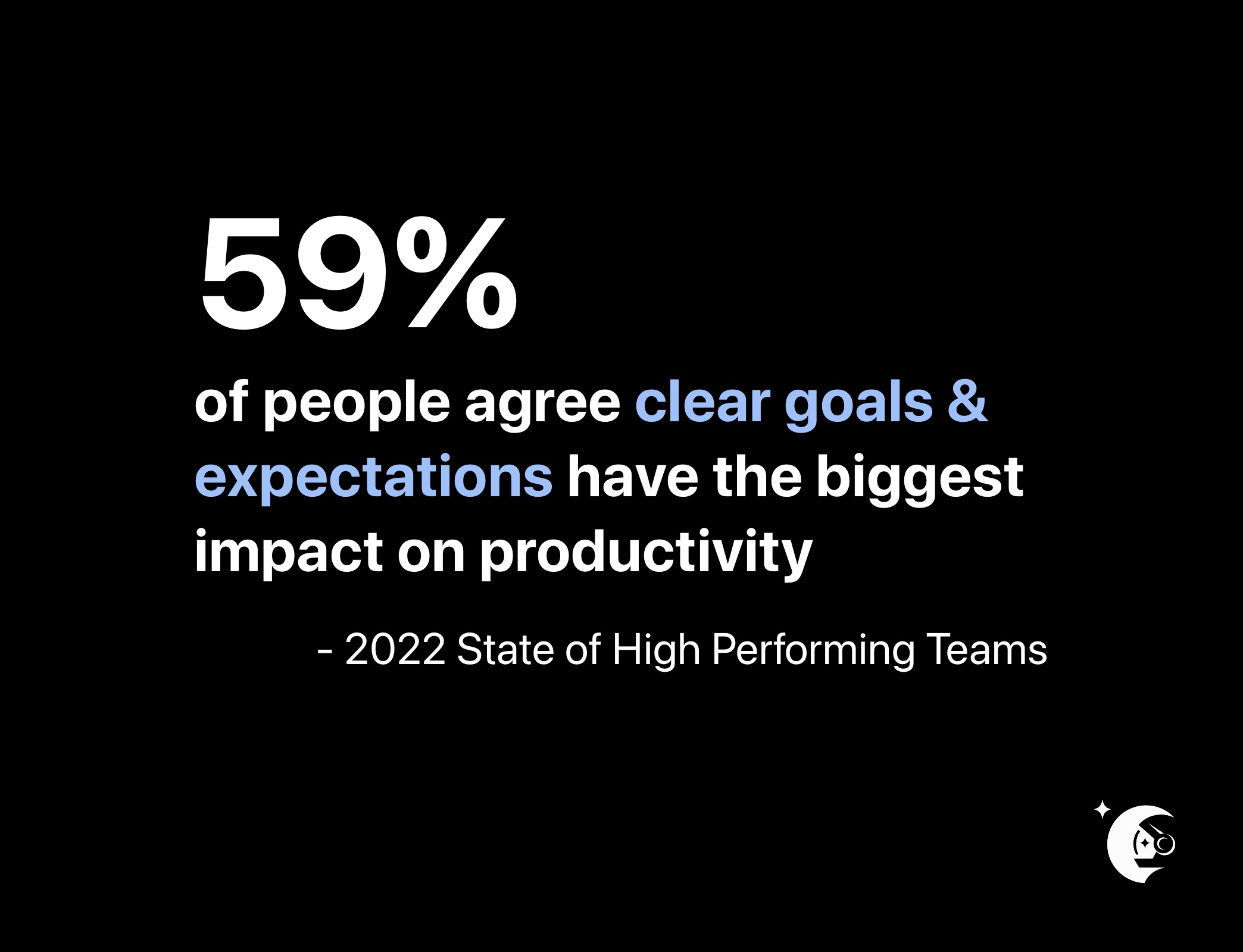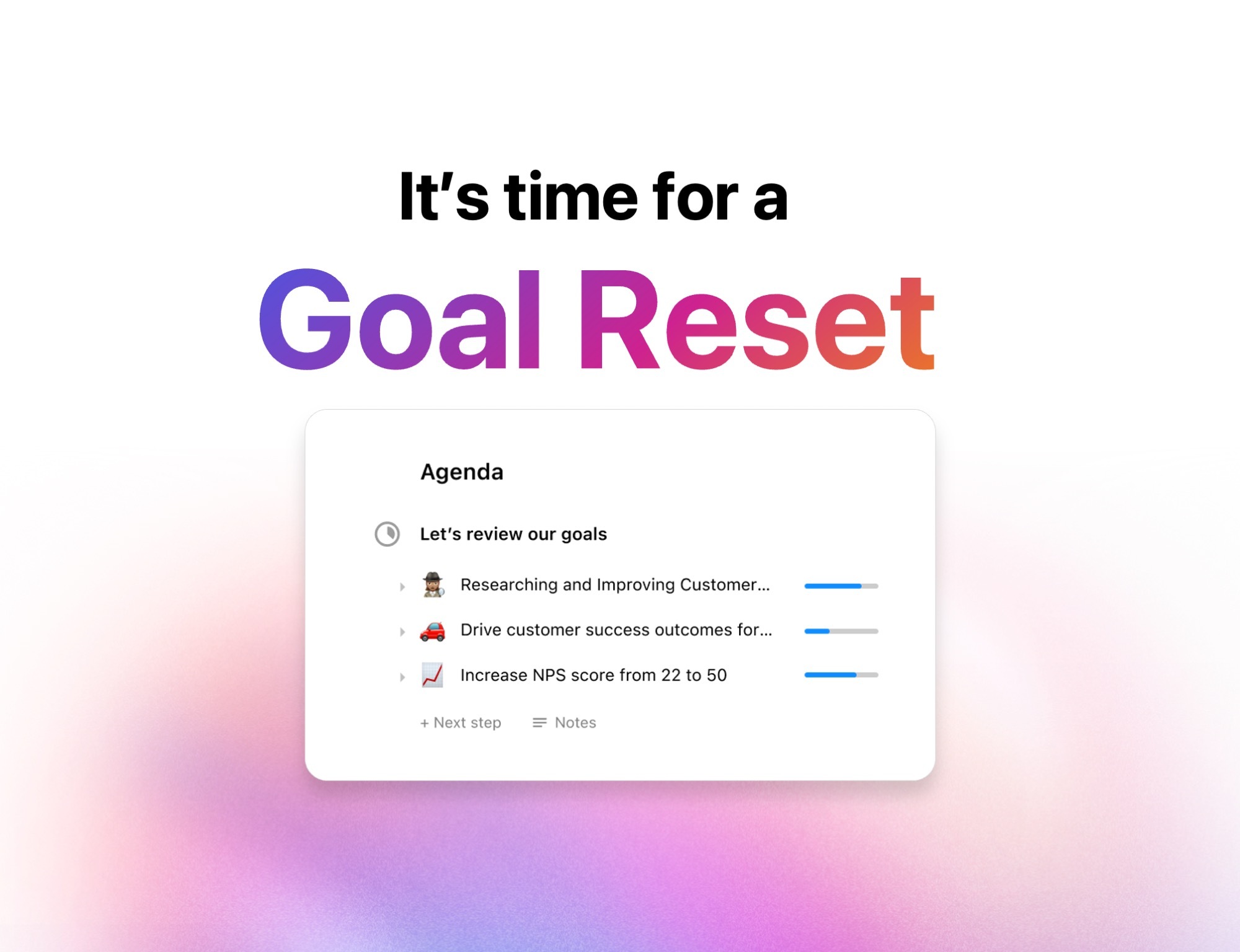How to write SMART goals (with examples)
10 min readLearn about what SMART goals are, how to write them and why this framework may (or may not) work for you and your team. Access a list of goals for employees, managers, and professional development.

If you’ve been in a professional role, chances are, you’ve encountered SMART goals at some point along the way (and if you haven’t, it’s only a matter of time). Whether you’ve recently been tasked with filling out your first SMART goals worksheet or are preparing your team to create SMART goals of their own, it’s important to understand how they work.
In this article, we’ll be taking a look at:
- What are SMART goals and objectives?
- The importance of SMART goal-setting
- The benefits and drawbacks of SMART goals
- Examples of SMART goals
Ready? Let’s begin!
What are SMART goals and objectives?
SMART is a goal-setting framework. It was developed in 1981 by consultant George Doran with Arthur Miller and James Cunningham, and quickly became the standard for charting organizational goals and objectives. Although more modern alternatives like OKRs and HARD goals have cropped up in recent years, SMART goals are still commonplace.
Goals vs. objectives: What’s the difference?
Before we go any further, let’s quickly talk about goals and objectives. There’s actually a major difference between the two, although they’re often used interchangeably.
Goals refer to the desired outcome to be achieved at some point in the future, either by an individual or organization. Think of it like the Big Picture: a broader statement or vision of where you want to go.
Objectives, on the other hand, are specific, short-term targets with measurable results.
SMART goals are considered to be objectives because they force you to break down broader aims into more focused and granular milestones.
What does the S.M.A.R.T. acronym stand for?
Let’s walk through each letter in a little more depth.

S = Specific
Your SMART goals need to be specific — otherwise, how will you know what you’re working towards? Paul J. Meyer, the founder of Leadership Management International, dives deeper into SMART goals in his book Attitude is Everything. He suggests asking yourself the following questions to determine the specifics of a particular goal:
- What?: What do you want to accomplish?
- Who?: Who is involved?
- Where?: Where will you accomplish it?
- When?: When will it happen?
- Why?: What are the particular reasons or benefits behind the goal? Why do you want to achieve it?
Example of a specific goal:
❌ Up your onboarding game
✅ Successfully onboard 12 new customers each week with a satisfaction score of 8 or above this quarter
M = Measurable
As the adage goes, you can’t manage what you can’t measure. And to measure, you have to have metrics — that is, quantifiable data points and benchmarks which objectively determine whether or not you’re on track to completing your goal. If you aren’t sure whether your goal is measurable, try answering these questions:
- How much? / How many?
- How will you indicate progress?
- How will you know when you’ve reached your goal?
Once the metrics are established, you’ll be able to monitor your progress, see what’s working (and what’s not) and make any necessary adjustments along the way.
Example of a measurable goal:
❌ Prioritize listening over speaking when managing your direct reports
✅ Ensure 50% of weekly one-on-one meeting agenda items in Hypercontext come from your direct reports this year
A = Achievable
You don’t want your goal to be so far out of reach that you’re set up to fail from the start. On the other hand, setting too low a bar can make your goal meaningless, and frankly, it’s just not as exciting to hit. Aim for that sweet spot in the middle: challenging, yet still attainable.
Here are some considerations:
- Is this goal realistic with your current resources? If not, what are you missing?
- Are there any time constraints?
- Are there any other limitations that might prevent you from achieving your goal?
- Do you need to level up any skills or knowledge in order to be successful? Will you need additional support from your team?
- Have other people in a similar position achieved this goal before?
Answering these questions will help you evaluate whether or not your goal is actually realistic or if it needs to be adjusted.
Example of an achievable goal:
❌ Go viral
✅ Get 3 Product Hunt influencers to upvote and comment on launch day
R = Relevant
When it comes to goal setting, you want to make sure everyone’s on the same page and working towards the same objectives, rather than interfering in one another’s success. That’s why it’s so important for individual SMART goals to align directly with the broader team and company goals.
Some good questions to ask include:
- Does this goal conflict with any team or company goals?
- How does this SMART goal support our team’s quarterly goals?
- How does this SMART goal support our company’s vision?
- Is now the right time to focus on this particular SMART goal?
Example of a relevant goal:
❌ Increase average opportunity value by 10%
✅ Have 80%+ of sales development reps hit or exceed their annual targets for the year
T = Time-bound
If you want to be successful with your SMART goals, they need to be bound to a specific date or timeframe. This keeps you on schedule and also holds you accountable — without a deadline, it could take you 10 years to achieve something you could have otherwise pulled off in a month.
When determining the right amount of time to allocate to a particular goal, ask yourself:
- What can you achieve this month? Quarter? Year?
- Is the time frame we’ve set possible?
- Can we get this done faster or do we need more time?
Example of a time-bound goal:
❌ Contribute more regularly to the company blog
✅ Write 3 articles about product best practices for the company blog this quarter
The importance of SMART goal-setting
Goals are crucial to the success of any organization — SMART or otherwise. Jay B. Barney and Ricky W. Griffin — authors of The Management of Organizations — identified four main functions of organizational goals:
- Providing guidance and direction
- Facilitating planning
- Motivating and inspiring employees
- Helping evaluate and control performance
However, not all goals are created equal. You’re far more likely to reach the goals you’ve committed to paper than the ones you’ve got floating around in your head. In fact, a study conducted by psychology professor Dr. Gail Matthews at the Dominican University in California found that people who record their goals on a regular basis are 42% more likely to actually achieve them.
It’s not just about writing things down, though. The last thing you want to do is scribble all your goals down in a mile-long to-do list, without any clarity, focus, or sense of direction. That’s where the SMART methodology comes in. It provides a framework for clarifying and recording your goals. More than anything, setting smart goals is a process that requires you to:
- Flesh out the details
- Determine important metrics
- Align with your broader team/company goals
- Commit yourself to a timeline
The result?
You’ll ultimately set yourself (and your team) up for a greater chance of success.
Benefits and drawbacks of SMART goals
Pablo Picasso wasn’t just fond of geometric faces. He was also fanatic about goal setting.
“Our goals can only be reached through a vehicle of a plan, in which we must fervently believe, and upon which we must vigorously act. There is no other route to success.”
– Pablo Picasso
It’s unlikely Picasso actually used the SMART goal system himself (it wasn’t formally developed until the 80s, after all). However, he did manage to create around 50,000 artworks in his lifetime — that’s an average of 2 per day. He was definitely onto something.
When it comes to structuring your own goals and building a concrete plan, the SMART methodology isn’t the only game in town. OKRs (objectives and key results) are another popular approach, and might even be a better fit for your team. The SMART goal system, however, has a lot to offer.
Benefits of SMART goals
There’s a reason why people managers have been using SMART goals for decades to keep their teams on track. When done right, SMART goals:
- Provide clarity and focus on what you and your team members need to accomplish in a particular quarter, year, or another set timeframe
- Offer an easy, structured approach to goal-setting
- Help keep your team aligned with company-wide objectives
Drawbacks of SMART goals
In spite of some clear advantages to the SMART goal system, it’s not without limitations. Let’s explore some drawbacks:
- Time-consuming: Creating SMART goals is a lengthy and labor-intensive process. This can negatively influence your mentality around goal setting in general and make it feel like a chore, rather than an opportunity to feel motivated about achieving your objectives.
- Overshadowing: Because SMART goals require such thorough planning, you may inadvertently wind up neglecting other objectives that haven’t received the same level of attention.
- Stifling: SMART goals are incredibly rigid, which leaves little room for out-of-the-box approaches, innovative solutions, and alternative perspectives.
SMART goal examples
We’ve talked about SMART goals and why they’re important. We’ve also discussed their advantages and disadvantages. But what about actual SMART goal examples?
SMART goal examples for employees
- Ask for feedback from your manager or a team member at least once per week this year
- Use the first 15 minutes of each day to prioritize what you need to get done for the day this quarter to help improve productivity
- Present on behalf of our team at demo day twice this quarter to sharpen your communication skills
- Have a one-on-one with three people from other teams this quarter to help reduce workplace silos
SMART goals for managers
- Run a recurring monthly coaching session with your team this year
- Give at least 2 pieces of actionable feedback a month to every direct report
- Meet with a management coach or mentor twice this quarter
- Host 3 asynchronous meetings this month to support a remote-first mindset
SMART goals for personal development
- Participate in 1 strategic thinking or planning course this year
- Connect with and meet 5 new people in your field but outside of our organization by the end of the quarter
- Ask for feedback from your manager or a team member at least once per week
- Collaborate on 1 project with someone from another department this quarter
Wrapping it up
Now you know what SMART goals are, how to write them and why this framework may (or may not) work for you and your team.
Whether you decide to go the SMART goal route or not, the most important thing to remember is this: take your goals seriously. Give them the time and attention they deserve and make sure they support your team, your organization, and your own personal development. You can even try adding them to the top of your shared meeting agendas to make them impossible to forget about. That way, you’ll be geared up for success, no matter the approach.
Now go forth and crush your goals — you’ve got this. 💪🏾
Want to learn more about effective goal-setting? Here are some of our top picks:


